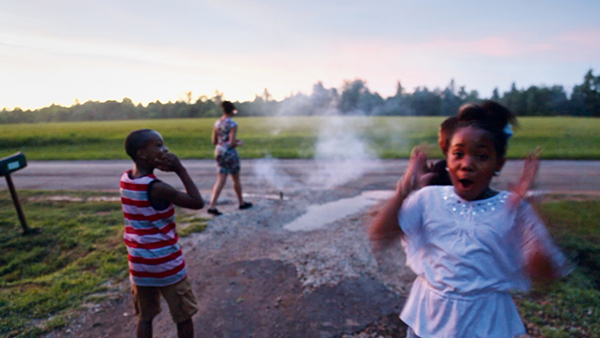Hale County This Morning, This Evening
Director/RaMell Ross
Watched on Independent Lens
Rating 4/5
Hale County This Morning, This Evening is composed of the fleeting, random moments that most other documentaries employ either as brief cutaways during the primary action, or as connective B-roll between narrative plot points. Out of 1300 hours of footage, RaMell Ross, the writer, director, cinematographer and editor, chose relatively few images to complete his 78-minute film, but they reveal a quality of black life that usually exists only on the margins in most other films about the black experience in America, films about prejudice, poverty, injustice, crime, incarceration, and racism.
Ross has made a film in which those issues are on the periphery. His interest, as a photographer, teacher, coach and mentor to the young men and women in this movie, is to refocus the quotidian details of their lives to the center of the frame. He was an outsider, in a sense, when he first moved to this Alabama county, a role which suggests he embedded himself into the landscape of everyday life and compiled a scrapbook made up of the rhythms of this self-contained world. He finds two or three characters he stays close to, but he does so almost shyly, obliquely, as if he is afraid to conventionalize his documentary.
He is most interested in texture. Drops of sweat hitting the basketball court cuts to raindrops on pavement. Popcorn popping at a concession stand cuts to bugs flitting in the magic hour light. Cheerleaders’ bodies sway in unison. Players run layup drills into the camera. Night skies become a time lapse diorama.
If you’re looking for a story to emerge from these sequences, look elsewhere. Ross’s indifference to a structural arc frees his camera to linger on wide shots, to study facial expressions in close-up, to gaze in quiet awe at a storm, or to indulge poetic flourishes like the brief bits of onscreen text which ask rhetorical questions. One of these, “Where does time reside?” is answered by the one episode of drama in the film, a sudden and surprising death that Ross and his subjects treat as ephemera, a lapse in time’s advance not explained by a speeded-up camera, but by the necessary obligation of continuing to live.
The only flaw in Hale County This Morning, This Evening is one not of the director’s making. The movie is far from indelible. The images nor the cutting between them are radical, the rudderless montages drift by with only a vague connection to a larger thought. All this is fine enough, but a burden of overpraise weighs the film down. Some critics have said the movie redefines cinematic language, but I think this reaction is less about Ross’s achievement and more about the paucity of imagination in contemporary documentary making (similar claims were made about Kirsten Johnson’s Cameraperson). Ross and Johnson (more specifically, her editor Nels Bangerter) merely used the same tools and grammar–composition, sound, movement, light, music, contrast, transitions–available to all filmmakers.
If more filmmakers made films like Hale County; if a new wave of dreamy, sensory-laden visual poems began breaking against the walls of documentary’s myopic gatekeepers, I suspect the industry would quickly disavow the experimenters as copycats, and point out that there is virtually zero financial incentive to promote these films. One or maybe two outriders a year are allowed to break through the commercial and critical circle of wagons, but the rest will continue to struggle in obscurity.

